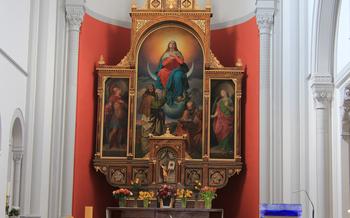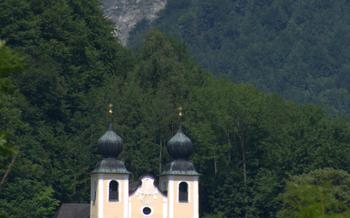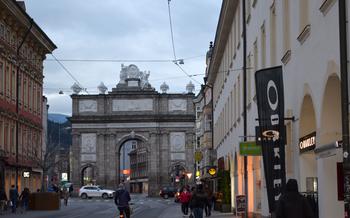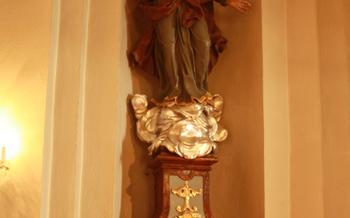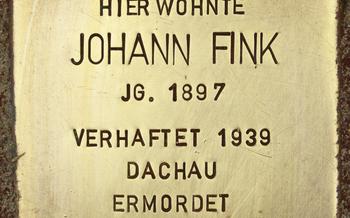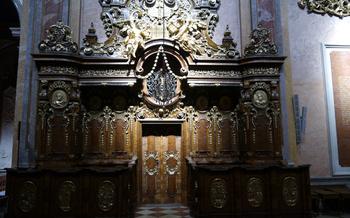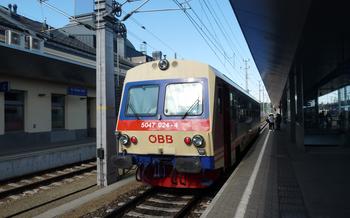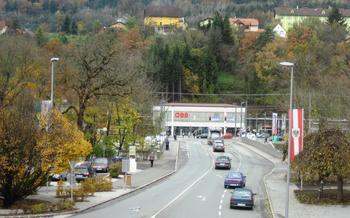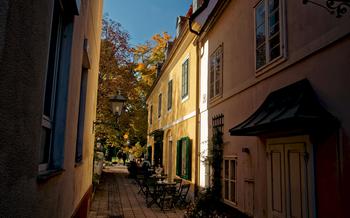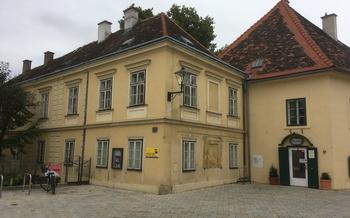
Kalvarienberg Church
- The Kalvarienberg Church in Baden bei Wien
- Location and Accessibility
- History and Background
- Architectural Highlights
- Religious Significance
- Visiting the Church
- Exploring the Interior
- Pilgrimage Tradition
- Events and Festivals
- The Stations of the Cross
- The Holy Cross
- Local Traditions and Customs
- Nearby Attractions
- Photography Tips
The Kalvarienberg Church in Baden bei Wien
The Kalvarienberg Church, a magnificent Baroque masterpiece, stands as a testament to the rich religious history and architectural heritage of Baden bei Wien. Constructed between 1712 and 1732, the church was commissioned by the Capuchin Order and designed by the renowned architect Jakob Prandtauer. Its striking appearance and profound religious significance have made it a must-see attraction for pilgrims and art enthusiasts alike.
The Kalvarienberg Church is not just a historical gem but also a deeply revered religious site. Dedicated to the Passion of Christ, the church features 14 Stations of the Cross, each meticulously crafted and arranged along a picturesque path leading up to the Calvary. Pilgrims from far and wide have flocked to this sacred place for centuries, seeking spiritual solace and a deeper connection with their faith.
Throughout the year, the Kalvarienberg Church hosts a variety of religious events and ceremonies, including masses, processions, and special services. During Holy Week, the church becomes the epicenter of Baden's traditional Passion plays, reenacting the final days of Jesus Christ with stunning performances and heartfelt devotion.
Location and Accessibility
Finding the Kalvarienberg Church
The Kalvarienberg Church stands prominently on the Kalvarienberg hill, a short distance from the center of Baden bei Wien. To reach the church, visitors can take a leisurely 20-minute walk from the city center, enjoying the picturesque streets and parks along the way. The exact address of the church is Kalvarienbergstraße 32, 2500 Baden bei Wien.
For those traveling by public transport, the ÖBB train line S45 stops at the Baden Josefsplatz station, a 5-minute walk from the church. Alternatively, several bus routes, including the 360 and 364, stop near the church, providing convenient access from different parts of the city.
For those arriving by car, limited parking spaces are available on Kalvarienbergstraße and the surrounding streets. It's recommended to arrive early to secure a parking spot, especially during peak tourist season.
History and Background
The history of the Kalvarienberg Church is deeply intertwined with the Catholic pilgrimage tradition. Its origins date back to the 17th century when a group of devout Catholics sought to create a place of worship dedicated to the Passion of Christ. In 1676, the foundation stone was laid, and the church was gradually constructed over the following decades.
As a pilgrimage site, the Kalvarienberg Church played a significant role in the religious life of the region. Pilgrims from near and far flocked to the church to venerate the Holy Cross, participate in processions, and seek spiritual renewal. The Stations of the Cross, a series of 14 tableaux depicting the Passion of Christ, were added in the 18th century, further enhancing the church's appeal as a pilgrimage destination.
Over time, the church underwent several changes and renovations. In the 19th century, the interior was extensively remodeled in the Baroque style, adding ornate decorations, intricate carvings, and stunning frescoes. The church's tower was also raised to its current height, creating a distinctive landmark visible from afar.
Throughout its history, the Kalvarienberg Church has been associated with numerous anecdotes and legends. One tale tells of a miraculous healing that occurred at the church, leading to its growing reputation as a place of divine intervention. Another legend speaks of a hidden treasure buried beneath the church, attracting fortune seekers and adventurers over the centuries.
Architectural Highlights
The Kalvarienberg Church in Baden bei Wien boasts a stunning Baroque architectural style, showcasing intricate design elements and opulent ornamentation. The exterior facade is adorned with elaborate sculptures, pediments, and cornices, creating a sense of grandeur and awe. The towering steeple, with its intricate carvings and copper-clad dome, dominates the skyline and serves as a beacon for pilgrims and visitors alike.
Stepping inside the church, visitors are greeted by a breathtaking interior that seamlessly blends Baroque opulence with a sense of sacredness. The main altar, a masterpiece of craftsmanship, features a stunning altarpiece depicting scenes from the life and crucifixion of Jesus Christ. The side chapels, each dedicated to a different saint or religious figure, are adorned with intricate carvings, paintings, and statues, creating a sense of awe and reverence.
The intricate ceiling frescoes, depicting biblical scenes and allegorical figures, are a testament to the artistic mastery of the Baroque era. The delicate stucco work, gilding, and marble accents add to the overall splendor of the interior, creating a harmonious and visually stunning space.
The Kalvarienberg Church is a true architectural masterpiece, showcasing the fusion of Baroque grandeur and religious devotion. Its intricate details, opulent ornamentation, and symbolic iconography make it a must-see attraction for anyone interested in art, architecture, or religious history.
Religious Significance
The Kalvarienberg Church holds immense religious significance as a pilgrimage site for Catholics. Its origins are deeply rooted in the Catholic tradition of pilgrimage, which involves journeys to holy places for spiritual growth and devotion. The church serves as a destination for pilgrims seeking to deepen their faith and connect with the divine.
During the 17th and 18th centuries, the Kalvarienberg Church became a prominent pilgrimage site, attracting thousands of believers from across the region. Pilgrims would embark on arduous journeys to visit the church, often walking barefoot as a sign of penance and devotion. The church's location on a hilltop further emphasized its spiritual significance, offering pilgrims a sense of elevation and connection with the heavens.
The veneration of the Holy Cross is central to the religious importance of the Kalvarienberg Church. The cross, a symbol of Christ's sacrifice and resurrection, is prominently displayed throughout the church, including on the main altar and in the Stations of the Cross. Pilgrims come to the church to pray, meditate, and seek solace through the Holy Cross, believing in its power to bring healing, forgiveness, and spiritual transformation.
The church also hosts special religious events and ceremonies throughout the year, including masses, processions, and festivals. These events provide opportunities for pilgrims and local worshippers to come together and celebrate their faith. Highlights include the annual Passion plays, which reenact the crucifixion of Jesus Christ and draw large crowds of visitors.
Visiting the Church
Opening hours and admission fees:
The Kalvarienberg Church is open to the public throughout the year, with varying hours depending on the season. Admission is free of charge, allowing visitors to experience its beauty and spiritual significance without any financial barriers.
Guided tours and information availability:
Guided tours are available for those who wish to delve deeper into the history, architecture, and religious importance of the church. Knowledgeable guides provide insights into the stories behind the artwork, symbolism, and traditions associated with the Kalvarienberg. Information boards and brochures are also available for self-guided tours, ensuring that visitors can learn about the church's rich heritage at their own pace.
Dress code and etiquette:
As a place of worship, visitors are expected to dress respectfully when visiting the Kalvarienberg Church. While there is no strict dress code, modest attire that covers the shoulders and knees is generally recommended. Additionally, visitors should maintain a respectful demeanor, avoiding loud noises and disruptive behavior, to create a serene and contemplative atmosphere within the church.
Tips for photography and capturing the beauty of the church:
The Kalvarienberg Church offers many opportunities for photography enthusiasts to capture its architectural grandeur and spiritual essence. To make the most of your shots, consider using a wide-angle lens to capture the sweeping views of the interior and exterior. Pay attention to the natural light, as the church's stained glass windows create stunning effects when the sun shines through. Remember to be respectful when taking photos during religious services or when there are other visitors present.
Exploring the Interior
Step inside the Kalvarienberg Church, and you'll be greeted by a breathtaking display of Baroque grandeur. The main altar, adorned with intricate carvings and golden accents, commands attention with its majestic presence. The central altarpiece depicts the crucifixion of Jesus, surrounded by a radiant array of cherubs and saints.
The side chapels, each dedicated to a different saint or devotion, offer their own unique charms. The Chapel of St. Anne, for example, features a delicate altar adorned with intricate stucco work and a captivating painting of the saint. The Chapel of St. Sebastian, on the other hand, showcases a haunting depiction of the martyred saint pierced by arrows.
Throughout the church, stained glass windows bathe the interior in a kaleidoscope of colors. These vibrant windows tell stories from the Bible, depicting scenes from the life of Jesus, the saints, and the Passion of Christ. Each window is a masterpiece of artistry, casting a divine glow upon the sacred space.
Don't miss the sculptures, paintings, and other religious artifacts that adorn the church's walls and altars. These exquisite works of art, crafted with devotion and skill, add to the church's rich visual narrative. From the expressive wooden carvings of the Stations of the Cross to the ethereal frescoes adorning the ceiling, every detail whispers a story of faith and devotion.
Pilgrimage Tradition
Throughout history, the Kalvarienberg Church has held a profound significance as a pilgrimage site for Catholics. Pilgrims from near and far have undertaken the journey to Baden bei Wien, seeking spiritual renewal and a connection to their faith. The pilgrimage tradition at the Kalvarienberg is deeply rooted in the Catholic belief in the power of prayer and the importance of following in the footsteps of Jesus Christ.
Pilgrims would often travel long distances on foot, enduring hardships and challenges along the way, as a form of penance and devotion. Upon arriving at the church, they would participate in various rituals and practices, such as praying the Stations of the Cross, venerating the Holy Cross, and attending special religious ceremonies. These rituals were seen as a way to connect with the suffering of Christ and to seek forgiveness for their sins.
In modern times, the pilgrimage tradition at the Kalvarienberg Church continues, albeit in a somewhat different form. While many pilgrims still choose to walk or cycle to the church, others opt for more convenient modes of transportation. The church remains a popular destination for both local and international pilgrims, who come to seek spiritual guidance, offer prayers, and experience the unique atmosphere of this sacred site.
For those who embark on the pilgrimage to the Kalvarienberg, it is not merely a physical journey but a spiritual one as well. It is an opportunity for reflection, prayer, and a deeper connection with their faith. The stories and experiences of pilgrims over the centuries have contributed to the rich tapestry of the Kalvarienberg's history, making it a place of profound spiritual significance.
Events and Festivals
The Kalvarienberg Church is not only a place of pilgrimage and prayer but also a vibrant venue for various events and festivals throughout the year. The annual Passion plays, held during Holy Week, are a highlight for both locals and visitors. These elaborate theatrical performances bring the story of Christ's crucifixion to life and attract thousands of spectators each year.
In addition to the Passion plays, the church hosts religious festivals and celebrations throughout the year. These events typically feature processions, music, and traditional Austrian cuisine. Visitors can immerse themselves in the local culture and experience the deep faith and devotion of the community.
Furthermore, the church occasionally hosts concerts, exhibitions, and cultural events. These events provide an opportunity to appreciate the church's stunning acoustics and beautiful surroundings while enjoying performances by talented musicians and artists. For those seeking a unique and enriching experience, attending one of these events is highly recommended.
Insider Tip:
For an unforgettable experience, plan your visit to coincide with one of the annual Passion plays. Remember to book your tickets well in advance, as they tend to sell out quickly. Also, be sure to arrive early to secure a good seat and soak in the atmosphere before the performance begins.
The Stations of the Cross
The Stations of the Cross, also known as the Way of the Cross, are a series of 14 small chapels or markers that depict the journey of Jesus Christ from his condemnation to his crucifixion and resurrection. At the Kalvarienberg Church, the Stations of the Cross are located along a path that leads up the hill to the Calvary Chapel. Each station features a scene from Jesus's Passion, with sculptures or paintings depicting key moments such as his trial, scourging, carrying the cross, and his death on the cross.
Pilgrims and visitors often follow the Stations of the Cross as a devotional practice, stopping at each station to pray, meditate, and reflect on the suffering and sacrifice of Jesus. The Stations serve as a reminder of the love and compassion of Christ, and his willingness to endure immense pain and suffering for the redemption of humanity.
The Stations of the Cross at the Kalvarienberg Church are a powerful and moving reminder of the final hours of Jesus's life. They offer a unique opportunity for visitors to connect with the story of Christ's Passion and to experience the journey of faith and redemption.
The Holy Cross
The Kalvarienberg Church is renowned for its veneration of the Holy Cross, which holds deep significance in Catholic tradition. According to legend, a fragment of the True Cross, on which Jesus Christ was crucified, was brought to the church in the 17th century. This relic became a focal point of pilgrimage and devotion, attracting countless believers seeking spiritual solace and connection to the sacred symbol.
The cross is prominently displayed in the church, serving as a reminder of Christ's sacrifice and the power of redemption. It is believed to possess miraculous healing properties, and many pilgrims have testified to experiencing divine interventions and blessings after visiting the church and praying before the cross.
Throughout the centuries, the Holy Cross has been a source of inspiration and hope for countless individuals. Its presence at the Kalvarienberg Church has transformed it into a sacred site, where believers can come to seek forgiveness, find comfort, and strengthen their faith in the power of God's love.
Local Traditions and Customs
The Kalvarienberg Church is deeply intertwined with the local traditions and customs of Baden bei Wien. During Holy Week, the church becomes the focal point of solemn processions and reenactments of the Passion of Christ. Locals and pilgrims alike participate in these events, carrying crosses and singing hymns as they follow the Stations of the Cross.
The church also hosts various festivals and special events throughout the year. The most notable is the annual Passion play, which has been performed for centuries and attracts thousands of visitors. The play brings the biblical story to life with elaborate costumes, music, and dramatic performances.
When visiting the church, it's worth exploring the surrounding area to discover the unique culinary delights of Baden bei Wien. Indulge in traditional Austrian dishes such as Wiener Schnitzel, Tafelspitz, and Sachertorte at one of the many charming cafes or restaurants nearby.
To fully immerse yourself in the local culture, take the time to interact with the friendly locals. They are proud of their heritage and traditions and will gladly share stories and insights about the Kalvarienberg Church and its significance.
Nearby Attractions
Baden bei Wien offers a wealth of attractions beyond the Kalvarienberg Church. History buffs can explore the Roman ruins of Aquae, a testament to the region's ancient past. The city also boasts several magnificent palaces, including the Weilburg Palace and the Rauhenstein Palace, which offer a glimpse into the opulent lifestyle of the Habsburg monarchy.
For those seeking a serene escape, the lush parks and gardens of Baden bei Wien provide a tranquil oasis. The Doblhoffpark, with its vibrant rose gardens and elegant sculptures, is a popular spot for leisurely strolls. The Kurpark, known for its thermal springs and medicinal waters, invites visitors to relax and rejuvenate.
Culture enthusiasts will delight in the city's vibrant arts scene. The Theater Baden, a renowned performing arts venue, hosts a diverse range of plays, concerts, and ballets. The Stadtmuseum Baden, housed in a former Capuchin monastery, showcases the city's rich history through exhibits and artifacts.
Baden bei Wien is also a culinary paradise, offering a delectable array of local specialties. From traditional Viennese cuisine to international flavors, there's something to satisfy every palate. Be sure to sample the city's famous "Kurkonditorei," a sweet treat made with almonds and marzipan.
To fully immerse yourself in the local culture, engage with the friendly residents of Baden bei Wien. They are known for their warmth and hospitality, and they are always happy to share stories and recommendations about their beloved city.
Photography Tips
The Kalvarienberg Church is a sight to behold, and capturing its essence through photography is an enriching experience. To capture the church's grandeur, use a wide-angle lens to take in the sweeping views of the exterior. Don't forget to experiment with different angles and perspectives to create dynamic compositions. Inside the church, the intricate details and colorful stained-glass windows demand attention. Use natural light to your advantage, as it illuminates the interior in a magical way. A tripod can help steady your camera for crisp shots. For the Stations of the Cross, consider taking a series of photos to document your spiritual journey. Share your stunning photographs online and inspire others to explore this magnificent pilgrimage site.
